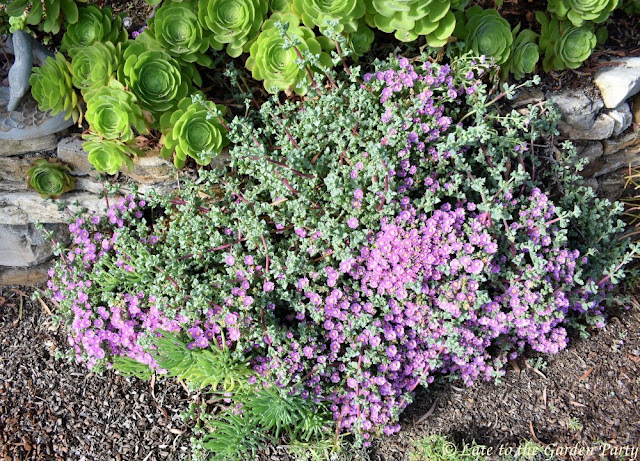I've been spending a lot of time in my garden, partly to escape the pandemonium associated with our remodel, but also in an effort to manage the garden's explosive growth following the best stretch of rain and moderate temperatures we've had in a long time. I could probably spend several hours a day for a solid month just cutting back
Erigeron karvinskianus and even then might have to start all over again with a fresh round of haircuts as soon as I finished. I've also spent gobs of time deadheading flowering plants, pulling weeds, and cleaning out ripened bulb foliage. In the midst of the last exercise, I took time to admire my sleek and always tidy succulents.
![]() |
| This is Aloe labworana, native to Uganda. I picked it up last August because I loved its wavy shape. Once I cut back the dead daffodil foliage surrounding it and uncovered the Echium debris that had nearly covered it, I noticed that it'd taken on a pretty red tinge. |
![]() |
| This Yucca gloriosa 'Variegata' had been nearly smothered by Erigeron karvinskianus (aka Santa Barbara daisy) and was partially hidden behind a tall mass of Gaura lindheimeri. I purchased the plant in a 4-inch pot about 18 months ago and it's still relatively small but someday it'll be big enough to hold its own in that spot against all comers. |
![]() |
| This Agave is sold under a variety of names but now is commonly known as Agave mitis 'Multicolor'. This is the largest of the 3 I have, given to me as a birthday gift 3 years ago. It's beefed up dramatically in the past year, presumably in response to the extra rain we received this past winter. |
![]() |
| There are several nice 'Blue Glow' and 'Blue Flame' Agaves here but what dials this vignette up a notch is the mass of Crassula pubescens ssp radicans in full bloom among the Agaves. The smaller succulent's red foliage nicely echoes the red edges of the 'Blue Glow' Agaves most of the year but the cream-colored flowers light up the bed in early summer. |
![]() |
| The same grouping from another angle. Please ignore the crabgrass I missed during my clean-up. |
Some succulents have joined the floral parade.
![]() |
| My Hesperaloe parviflora aren't as exuberant as the plants I saw at last year's Garden Bloggers' Fling in Austin, Texas but I'm pleased with the statement they make here and I'm hopeful that, in time, my 3 plants will form large clumps. |
![]() |
| I fell in love with Oscularia deltoides (aka Lampranthus deltoides) several years ago based on its foliage alone. Its red stems are covered in icy blue-green leaves. Like many succulents, it's easily grown here simply by sticking a cutting in soil. This one is happy trailing down a low stacked stone wall in partial shade. I have others growing in full sun but in my location they look best with some afternoon shade. |
![]() |
| The bloom spikes on the 2 Agave desmettiana growing in my street-side bed formed in October. The plants were in full bloom in March. It appears that bulbils are finally forming, although thus far most are well above my head and therefore hard to photograph. Meanwhile the mother plants' foliage has taken on a pretty reddish color. |
![]() |
| The 3 Agave desmettiana 'Variegata' growing on the slope here are also progeny of the 2 plants currently in bloom. I planted 5 pups in this area (not all visible in this photo) several years ago when I put the original plants in the street-side bed. They also got a major boost from our winter rains. |
Blooms are a mixed bag when the blooming plant is monocarpic, as most Agaves are. But, if the Agave desmettiana produce a host of baby plants, that'll take the sting out of the loss of the 2 large specimens. I only hope the bulbils develop fully before those 2 bloom stalks fall into the street.
All material © 2012-2019 by Kris Peterson for Late to the Garden Party







